Water for Health Sanitation Recreation
Ms. Ng Khar Thoe
(Specialist, Research and Development Division, SEAMEO RECSAM)
Prof. Dr. P.M.Sivalingam
(Country Director IRDCA, Consultant-UN & UNEP, Ex-USM Prof. in Biology)
Ms. Tan Huey Ning
(HVWSHE National Focal Point, Curriculum Development Centre,
MOE Malaysia)
Dr. Lakshmi Seetharam
(MD and Director, Institute of Sathya Sai
Education, Philippines)
Would you like to live
in the environment......that is affected
by water and
air pollution and
excessive flood?
OR
surrounded by stretches
of beautiful beaches...
...with water serving the roles to
support life and for recreation?
Would you like your house...
...to be easily hit by flood
during rainy seasons?... OR
Do you prefer your house
to be located by the
river banks or seaside...
..with good sanitation facilities
and potentials for ecotourism?
Objectives of plenary discussion session for Thematic Strand 2: “Water for Health, Sanitation and Recreation”
and “recreation” and the importance of water for “health,
sanitation and recreation” as essential elements stated by World
Health Organization in the principles of “Primary Health Care”.
lifelihood with the understanding of the interrelationships and
interactions among water with “health, sanitation and recreation”
and research findings by scientists and/or researchers in
GOs/NGOs/industries related to Thematic Strand 2 from
the aspects of Science, Mathematics and Social Sciences.
integration of values in Thematic Strand 2.
• To adapt the knowledge and understanding in Thematic
Strand 2 as well as the HVWSHE resource materials
available into the existing curriculum in SEAMEO countries.
Definitions with interrelationships and interactions among...
Health
Water
Sanitation
Recreation
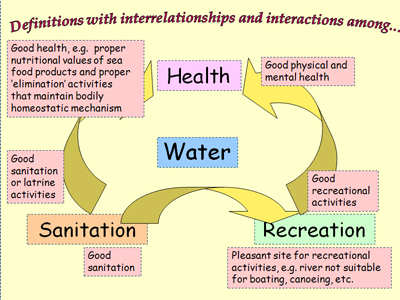
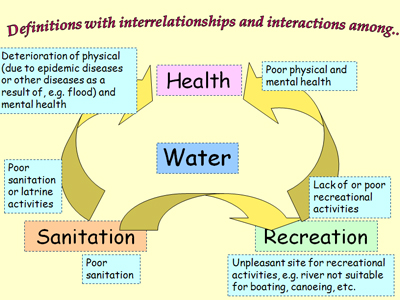
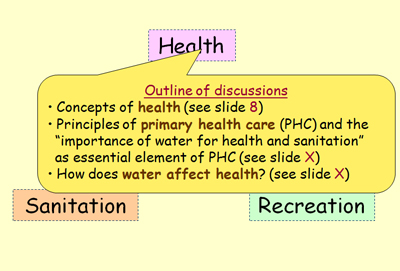

Primary Health Care : Definition and Role
• includes at least the following eight essential elements of health care :
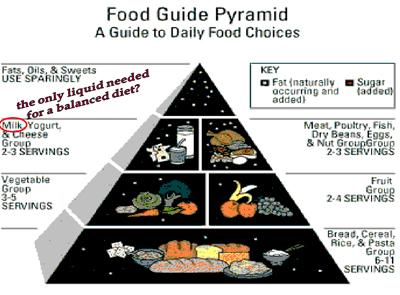
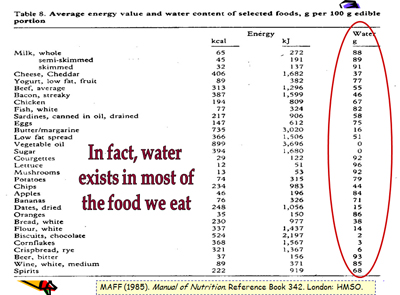
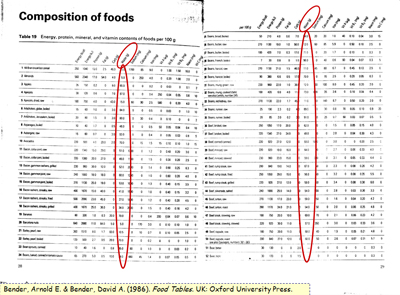
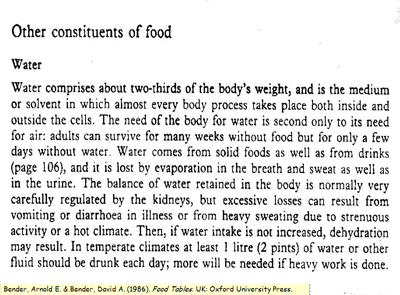

Homeostasis of body temperature
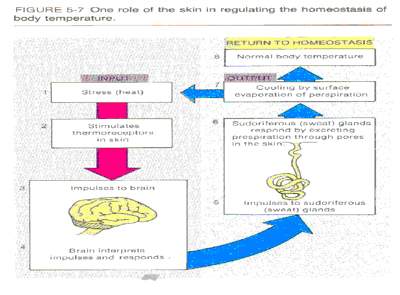
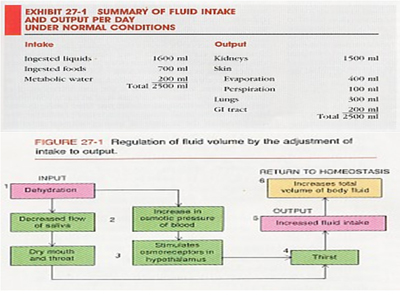
Tortora, G.J. and Anagnostakos, N.P. (1990). Principles of Anatomy and
Physiology. Sixth Edition. HarperCollins Publishers.
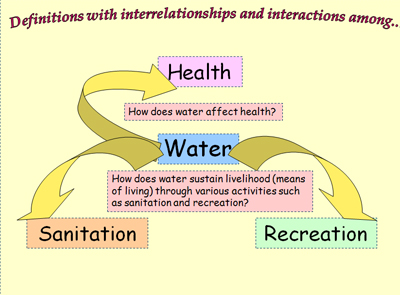
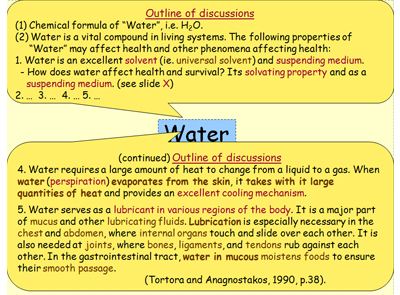
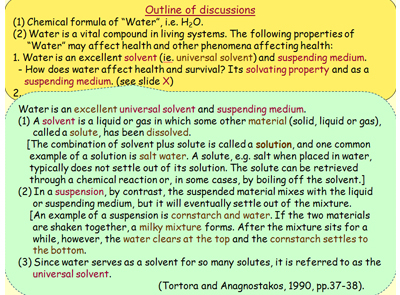
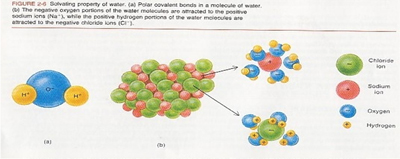
With the solvating property and as a suspending medium, water is essential to health and survival.
(1) The solvating property of water that affects health:
E.g.(a) If the surfaces of the air sacs in our lungs are not moist (i.e. no water),
oxygen cannot dissolve and therefore cannot move into your blood to be
distributed throughout our body.
(b) Water is the solvent that carries nutrients into and wastes out of our
body cells.
(2) As a suspending medium, water is also vital to our survival:
E.g. Many large organic molecules are suspended in the water of our body cells.
These molecules are consequently able to come in contact with other
chemicals, allowing various essential chemical reactions to occur.
(Tortora and Anagnostakos, 1990)
Health Education : An important aspect for the
prevention and control of illness and disease (cont'd)
Raising awareness on the importance of balanced diet :
Balanced diet is the diet consists of all classes of food groups (i.e. carbohy-drates, protein, fat, vitamins, mineral salts, fibre and water) in right/correct amount, proportion or ratio, appro-priate or adequate/ enough to maintain good health and prevent certain illness. Good nutrition translates to daily good health and a high level of energy. Eating foods in variety, regular, balance and moderation ensure that the nutrient and energy requirements of our body are met with minimal excesses. Our body requires over 40 different nutrients in all food groups.
Drinking at least 8 glasses of water is important in helping our cells remove waste, cooling our body and replenishing moisture content within our body.
However………
Excessive drinking of water can also be lethal or causing death as too much water will flush away body’s vital chemicals and cause death as a result of water intoxication (a condition whereby blood was found to be diluted and body salts are destroyed in a process called hyponatraemia).
… Also the way we prepare food can also cause the loss of certain amounts of nutrients. For example…
MAFF (1985). Manual of Nutrition. Reference Book 342. London: HMSO.
One must understand while cooking that various vitamins may be lost due to “heat, light, air, water, acid, alkali, etc.”. For example,
(1) Vitamin E is not soluble in water,
(2) Vitamin B are all water soluble,
(3) Vitamin C is water soluble and are readily destroyed by air.
Sanitation
Outline of discussions
- Refer article “Sanitation Teething Problems of Basic
Household Wastewater and Sewage Treatment Outdated
Approaches” by Prof.Dr.Sivalingam.
Recreation
Outline of discussions
(1) “Recreation” means (form of) play or amusement; refreshment of body and mind; something that pleasantly occupies one’s time after work is done (Hornby, 1974).
(2) Functionally,recreation is the natural expression of human interests and needs seeking satisfaction during leisure. The most used definition: “Recreation is the worthy use of leisure (freedom from the demands of work or duty)”. Recreation is value derived. It contributes to mental health, physical well-being, creativity, personality development, satisfaction, self-assertion, pleasure, etc. In sociological terms, ‘recreation’ includes many types of activities which are undertaken for their own sake and not for any reward or goal beyond themselves, and which are relatively free, spontaneous, and enjoyable. Such activities are motivated primarily by interest and give more or less immediate satisfaction, and has no ulterior purpose. It might involve a tremendously broad set of possible interests that range from sports, hobbies and social cultural interests, to mathematical, scientific or exploratory involvements. (Trant, et al., 1980; Shivers, 1981; MOEBC, 1986).
Kayaking
Sea Walker
water park
canoeing
boat ride
eco park
landscape waterfall
What happens to food after we eat it?
Problems in the digestive system
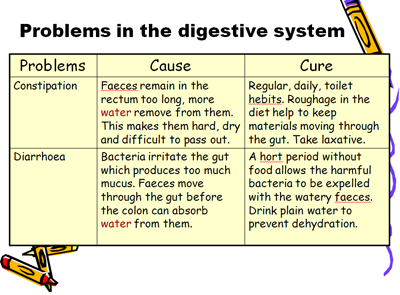
Although water is essential for sustaining healthy living, it can also be the causes of health hazards. For example, as a dangerously good conductor of electricity, water may cause the risk of a shock if handling appliance with wet hands.
Other water related health hazards are such as drowning and hypothermia (the condition whereby body temperature falls below 35oC).
Marsden, Andrew K., Moffat, S.C. & Scot, R. (1992) (Eds.). First Aid
Manual. London: Dorling Kindersley.